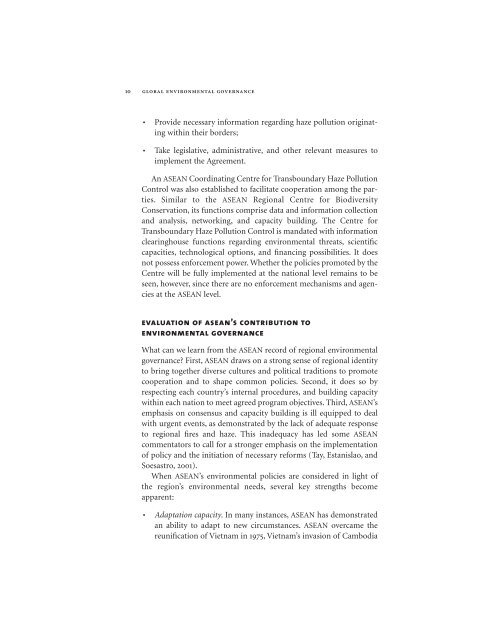Regional Environmental Governance: Examining ... - Yale University
Regional Environmental Governance: Examining ... - Yale University
Regional Environmental Governance: Examining ... - Yale University
Create successful ePaper yourself
Turn your PDF publications into a flip-book with our unique Google optimized e-Paper software.
10<br />
GLOBAL ENVIRONMENTAL GOVERNANCE<br />
• Provide necessary information regarding haze pollution originating<br />
within their borders;<br />
•<br />
Take legislative, administrative, and other relevant measures to<br />
implement the Agreement.<br />
An ASEAN Coordinating Centre for Transboundary Haze Pollution<br />
Control was also established to facilitate cooperation among the parties.<br />
Similar to the ASEAN <strong>Regional</strong> Centre for Biodiversity<br />
Conservation, its functions comprise data and information collection<br />
and analysis, networking, and capacity building. The Centre for<br />
Transboundary Haze Pollution Control is mandated with information<br />
clearinghouse functions regarding environmental threats, scientific<br />
capacities, technological options, and financing possibilities. It does<br />
not possess enforcement power. Whether the policies promoted by the<br />
Centre will be fully implemented at the national level remains to be<br />
seen, however, since there are no enforcement mechanisms and agencies<br />
at the ASEAN level.<br />
evaluation of asean’s contribution to<br />
environmental governance<br />
What can we learn from the ASEAN record of regional environmental<br />
governance First, ASEAN draws on a strong sense of regional identity<br />
to bring together diverse cultures and political traditions to promote<br />
cooperation and to shape common policies. Second, it does so by<br />
respecting each country’s internal procedures, and building capacity<br />
within each nation to meet agreed program objectives. Third, ASEAN’s<br />
emphasis on consensus and capacity building is ill equipped to deal<br />
with urgent events, as demonstrated by the lack of adequate response<br />
to regional fires and haze. This inadequacy has led some ASEAN<br />
commentators to call for a stronger emphasis on the implementation<br />
of policy and the initiation of necessary reforms (Tay, Estanislao, and<br />
Soesastro, 2001).<br />
When ASEAN’s environmental policies are considered in light of<br />
the region’s environmental needs, several key strengths become<br />
apparent:<br />
• Adaptation capacity. In many instances, ASEAN has demonstrated<br />
an ability to adapt to new circumstances. ASEAN overcame the<br />
reunification of Vietnam in 1975, Vietnam’s invasion of Cambodia
















